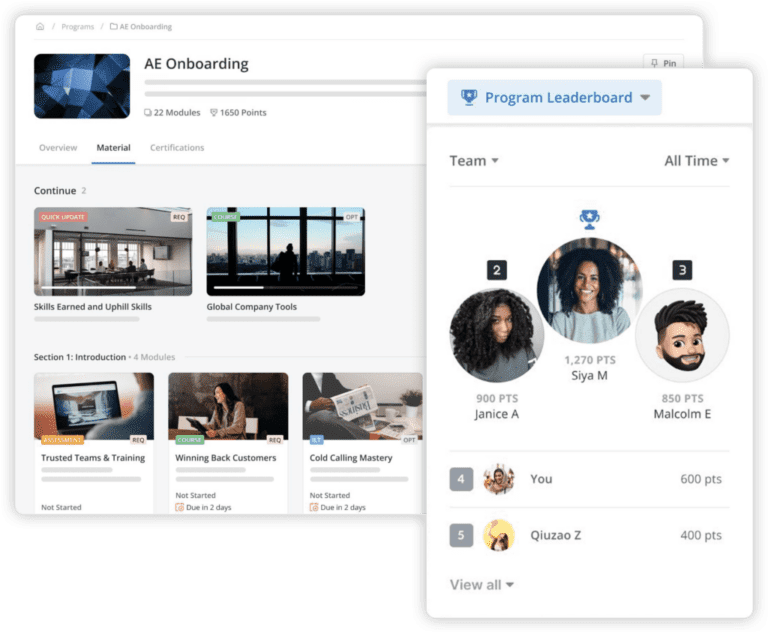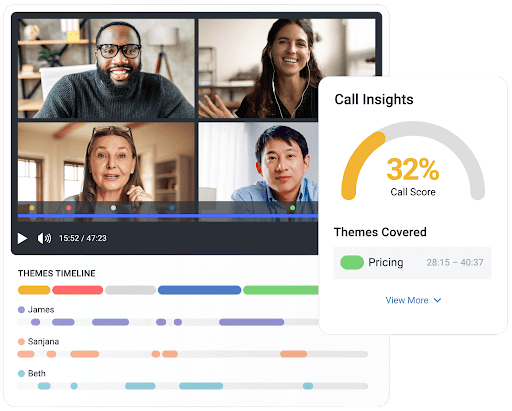If you scroll through LinkedIn, you’ve likely seen many sales reps identify themselves as consultants in their titles.
But simply calling yourself a consultant doesn’t mean you’re actually acting as a consultant during the sales process.
In many cases, sellers engage in product-based selling, which involves pushing the features and benefits of a given product – without regard for whether these features and benefits are relevant to the customer.
This approach may have worked in the past.
But in today’s world, product-based selling will no longer cut it.
What you will learn
- We’ll explore what consultative selling is
- How it differs from traditional selling
- How it can set your organization apart from the competition
- Best practices for putting consultative selling into practice at your organization to start seeing results ASAP
Modern buyers are more informed than ever and often do plenty of research on their own before contacting a seller. These buyers also have high expectations for great experiences throughout the purchase journey. The most successful sales organizations are adopting a consultative selling approach to meet buyers’ lofting expectations – and start closing more deals, faster.
What is consultative selling?
First things first, what is consultative selling? Consultative selling (commonly referred to as needs-based selling) is a sales methodology focused on understanding the needs of the buyer – and then offering the best solution to fit those needs. Consultative selling can take place in person, but increasingly, it happens virtually.
Those who practice consultative selling prioritize relationship-building. Sellers take the time to truly understand the challenges and pain points of each prospective buyer and gain their trust. Then, those sellers tailor their solutions and messaging to address the buyer’s unique needs.
To illustrate consultative sales in action, consider your most recent, significant purchase – either in your professional or personal life. Most likely, you found yourself in one of two scenarios. Perhaps you worked with a pushy sales rep who waxed poetic on all the features and benefits of the product – regardless of whether those features and benefits were actually relevant to your needs. They may have also shared generic collateral with you covering information you already uncovered on your own.
Or, perhaps you had the opportunity to work with a sales rep who listened to your needs, answered all of your questions, asked some of their own thoughtful questions, and ultimately, delivered personalized, relevant experiences that helped you come to the conclusion that their solution was the best fit for your needs.
If you experienced the latter, you experienced consultative sales in action.
Consultative selling requires the right tools and technology. For example, organizations need sales training software to ensure their reps have the training required to be consultative sellers. They can also use this software to deliver continuous learning to ensure reps have the skills they need – whether their sales interactions are in the field or virtual.

Solution selling vs. consultative selling: how they differ
Consultative selling is a vastly different approach from traditional selling and requires a different set of selling skills. While the benefits are many (we’ll cover some of those benefits later on), it can be a huge shift in mindset for sellers accustomed to traditional, product-focused selling.
Traditional selling is transactional; reps are focused on winning that one sale. On the other hand, consultative selling is focused on building relationships with buyers. Those relationship-building efforts enable reps to position themselves as trusted advisors, rather than pushy sellers.
In addition, traditional selling focuses on pushing the features and benefits of the product in question – without any regard for how those features may (or may not) help the seller achieve their goals. Conversely, consultative sellers work to understand the needs of each buyer. They practice active listening and ask thoughtful questions to gain deeper understanding. Then, they offer solutions that will address the buyer’s unique pain points and help them achieve their goals.
Solution selling
Consultative selling
- Transactional
- Reps focus on delivering their sales pitch
- One-size-fits-all experiences and messaging
- Focused on the features of the product
- Seller is in the driver’s seat
- Prioritizes relationship-building
- Reps focus on understanding the buyer’s needs and pain points
- Experiences and messaging are tailored to the specific buyer
- Focused on the benefits to the specific buyer
- Buyer is in the driver’s seat, with the seller guiding them along the way
Traditional, product-focused selling may still work in some circumstances – namely, low dollar value transactions.
However, traditional selling simply isn’t effective for high-touch B2B sales. B2B sales organizations must make the shift to a consultative selling methodology if they expect to meet their targets and grow revenue.
Benefits of consultative selling
Increasingly, sales orgs are shifting from traditional, transactional selling approaches to consultative selling. This isn’t surprising, as the consultative sales approach delivers myriad benefits to buyers and sellers alike.
If you’re delivering the same, generic pitch to every buyer, they’re likely to tune you out. When sellers take the time to get to know a buyer and share solutions to their key challenges, it leads to a much more engaging experience for buyers.
Reps who practice consultative selling are able to demonstrate their understanding of a buyer’s business and needs – and deliver personalized solutions that meet those needs. Buyers are more likely to purchase a customized solution from a trusted consultant.
Consultative sellers take the time to understand a prospect’s pain points. By doing their research and asking the right questions, these reps can shed light on unrecognized needs. This can lead to larger deal sizes.
Consultative selling is all about relationship-building. When reps build rapport with customers, they’re more likely to stick around long term. They may even refer others in their networks looking to solve similar challenges.
1. Do your research
These days, buyers do plenty of research before reaching out to a sales rep. Make sure you’re doing your research, too. This background work is key to getting started on the right foot with the prospect.
The company’s website and LinkedIn are great starting places to uncover insights. Industry publications and social media can also be great sources of information. In addition, be sure to check your CRM for information on any past interactions with the company.
You’ll want to gain a deep understanding of things like:
- Who the company is
- Company size
- Product and service offerings
- Target market
- Key competitors
- State of the industry
Remember: the goal is to uncover as much information as possible about the company and your point of contact. This research will lay the foundation for a successful consultative selling process.
2. Ask the right questions
There’s plenty you’ll be able to learn about your prospect through your research. But this won’t tell you all you need to know to make recommendations.
You’ll also need to ask plenty of questions to gain a full understanding of your prospect’s needs and pain points. Don’t pose generic discovery questions, though. Instead, tailor your questions to the prospect and what you’ve already learned about them through your research.
Remember: nobody wants to feel like they’re being interrogated. While it’s important to ask questions, be sure you’re giving your prospect plenty of opportunity to ask their own questions, too. Per our 2023 State of Sales Productivity Report, on average, customers speak 38% of the time on calls. However, customers speak 57% of the time during top reps’ discovery calls.
3. Actively listen
It’s important to ask the right questions. But it’s just as important to actively listen to your prospect’s answers. This sounds simple enough, but it’s an area where many reps struggle.
When your prospect is answering your questions, be sure you’re giving them signals to indicate you’re listening. Avoid distractions, remain engaged in the conversation, and paraphrase their answers to ensure understanding. Be sure to add value to your summaries whenever possible. Active listening is key to building trust with the prospect.
4. Diagnosis the problem – and determine how you can help
Based on your background research and your conversations with your prospect, you should have a clear understanding of their current state – and their goals for the future. You should also understand what their main problem or challenge is. The next step is to determine how (and whether) you have a solution to help them overcome their key challenges and achieve their primary goals.
5. Educate and provide value
Once you’ve identified your prospect’s problem and figured out the right solution, it’s time to educate your prospect and provide value, whenever possible.
This is the point in the consultative selling process where you can tap into your industry knowledge to offer insights on how the prospect can overcome their problem. You may even have a case study focused on how a similar company overcame a similar problem.
If your product offering is a good solution for a prospect’s solutions, you can also educate them on how it’ll help them overcome challenges. But remember: one-size-fits all sales presentations and collateral won’t cut it. It’s essential to tailor your materials and your conversations to the needs of each buyer.
6. Guide prospects to a decision
In traditional selling, the rep is in the driver’s seat, attempting to push the deal to the finish line. However, in consultative selling, it’s a more collaborative process.
Be prepared to answer questions and overcome objections. In addition, remain patient – and avoid being pushy. The time and effort you’ve spent gathering information and building rapport will help you guide your prospects to a decision.
Consultative selling with Mindtickle
Consultative selling requires a shift in mindset for those accustomed to more traditional selling approaches. However, the effort is worth it as consultative sales empowers sellers to engage buyers, become trusted advisors, and close more deals more quickly.
But shifting to a consultative selling methodology doesn’t just happen with a flip of the switch. Instead, it’s imperative to equip your teams with the training and tools they need to be successful with consultative selling.

Mindtickle empowers businesses with a single, powerful platform that incorporates sales training, sales enablement, and call insights. Sellers can access all training and content they need to learn the ins and outs of consultative selling. In addition, they can turn to the Mindtickle revenue productivity platform to find the content they need to guide each sale toward the finish line. Finally, sales managers can tap into call insights to understand where their sellers are shining – and where they need more coaching to improve their consultative selling techniques.
There’s no need for sellers to juggle different, disparate platforms. Everything they need to ace consultative selling is within the Mindtickle platform.
Learn more about how Mindtickle can help your teams conquer consultative selling, or request a personalized demo today.
Build a team of Consultative Sellers
Ready to see how Mindtickle can train and reinforce consultative selling skills on your sales team?
Get a DemoThis post was originally published in September 2023 and was updated in January 2024.



 By Helen Waite
By Helen Waite
 By Christian Pieper
By Christian Pieper
